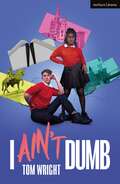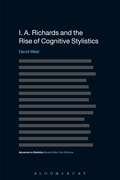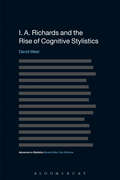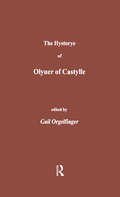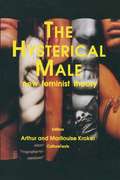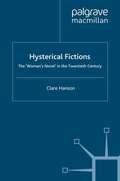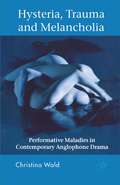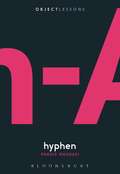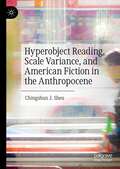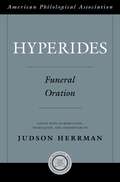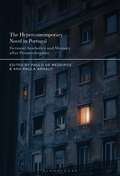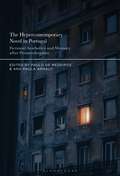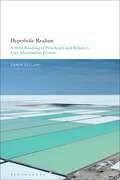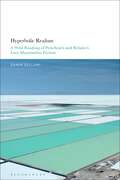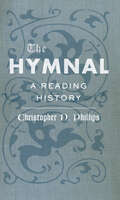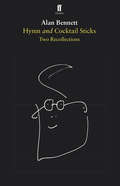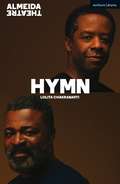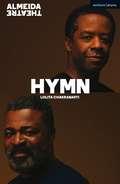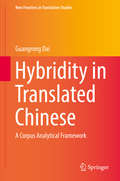- Table View
- List View
I Ain't Dumb (Modern Plays)
by Tom WrightA tough inner-city school, proud of its inclusivity, suddenly explodes in a rapidly escalating culture war.Sex secrets, hip-hop and hope fight for centre stage in a vibrant, loud and proud, real talk rollercoaster.Tom Wright's hard-hitting new play tackles contemporary issues in a school setting, published to coincide with Coventry's year as City of Culture.
I Ain't Dumb (Modern Plays)
by Tom WrightA tough inner-city school, proud of its inclusivity, suddenly explodes in a rapidly escalating culture war.Sex secrets, hip-hop and hope fight for centre stage in a vibrant, loud and proud, real talk rollercoaster.Tom Wright's hard-hitting new play tackles contemporary issues in a school setting, published to coincide with Coventry's year as City of Culture.
I. A. Richards and the Rise of Cognitive Stylistics (Advances in Stylistics)
by David WestI. A. Richards is an influential figure in literary criticism but has rarely been thought of as someone who laid the foundations for cognitive stylistics. This book proposes that Richards was a "protocognitivist".West argues that Richards anticipated many of the discipline's core aims, methods and assumptions. The book argues that the roots of cognitive psychology lie in early 20th-century psychology, when there was a focus on cognitive processes such as memory and learning, attention, categorisation, perception and consciousness. It was this cognitive psychology that Richards drew upon to build a theory of literature and interpretation - which in itself prefigured cognitive stylistics.West also suggests that Richards is one of the more influential British intellectuals of the 20th century, and that his work is still relevant today. West argues that cognitive stylistics is not, as Peter Stockwell has written, a "new science of literature and reading", but rather a discipline with a history that it continues to deny itself.This book will appeal to researchers and advanced students in stylistics and literary studies.
I. A. Richards and the Rise of Cognitive Stylistics (Advances in Stylistics)
by David WestI. A. Richards is an influential figure in literary criticism but has rarely been thought of as someone who laid the foundations for cognitive stylistics. This book proposes that Richards was a "protocognitivist".West argues that Richards anticipated many of the discipline's core aims, methods and assumptions. The book argues that the roots of cognitive psychology lie in early 20th-century psychology, when there was a focus on cognitive processes such as memory and learning, attention, categorisation, perception and consciousness. It was this cognitive psychology that Richards drew upon to build a theory of literature and interpretation - which in itself prefigured cognitive stylistics.West also suggests that Richards is one of the more influential British intellectuals of the 20th century, and that his work is still relevant today. West argues that cognitive stylistics is not, as Peter Stockwell has written, a "new science of literature and reading", but rather a discipline with a history that it continues to deny itself.This book will appeal to researchers and advanced students in stylistics and literary studies.
The Hystorye of Olyuer of Castylle (Medieval Texts Series)
by Gail OrgelfingerIn 1518, Wynkyn de Worde, Caxton’s successor as book publisher in London, issued a translation by Henry Watson of the Franco-Burgundian romance L'Istoire d'olivier de castille. The romance had already enjoyed great popularity on the Continent, having been printed first in French in 1482, in Spanish in 1499, in Flemish c. 1510 and in German in 1521.^ An Italian edition would follow in 1552. And another English version, this time translated from the Italian, appeared in 1695. Here an English translated version.
The Hystorye of Olyuer of Castylle (Medieval Texts Series #No. 14)
by Gail OrgelfingerIn 1518, Wynkyn de Worde, Caxton’s successor as book publisher in London, issued a translation by Henry Watson of the Franco-Burgundian romance L'Istoire d'olivier de castille. The romance had already enjoyed great popularity on the Continent, having been printed first in French in 1482, in Spanish in 1499, in Flemish c. 1510 and in German in 1521.^ An Italian edition would follow in 1552. And another English version, this time translated from the Italian, appeared in 1695. Here an English translated version.
The Hysterical Male: New Feminist Theory (Culture Texts)
by Arthur KrokerdThe Hysterical Male is designed as a thematically focussed exploration of gender politics in the 1990s. Initiated as a companion volume to Body Invaders it provides an intense, provocative and creative theorization of feminism under the failing sign of male hystericization.
Hysterical Fictions: The 'Woman's Novel' in the Twentieth Century
by C. HansonThe woman's novel is a term used to describe fiction which, while immensely popular among educated women readers, sits uneasily between high and low culture. Clare Hanson argues that this hybrid status reflects the ambivalent position of its authors and readers, as educated women caught between identification with the male-gendered intellectual culture and a counter-experience of female embodiment. Through six case studies, the representation of a 'mind/body problem' is explored in the fiction of Rosamond Lehmann, Elizabeth Bowen, Elizabeth Taylor, Margaret Drabble, A.S.Byatt and Anita Brookner.
Hysteria, Trauma and Melancholia: Performative Maladies in Contemporary Anglophone Drama
by C. WaldHysteria, trauma and melancholia are not only powerful tropes in contemporary culture, they are also prominent in the theatre. As the first study in its field, Hysteria, Trauma and Melancholia explores the characteristics and concerns of the Drama of Hysteria, Trauma and Melancholia through in-depth readings of representative plays.
Hyphen (Object Lessons)
by Pardis MahdaviObject Lessons is a series of short, beautifully designed books about the hidden lives of ordinary things.To hyphenate or not to hyphenate has been a central point of controversy since before the imprinting of the first Gutenberg Bible. And yet, the hyphen has persisted, bringing and bridging new words and concepts. Hyphen follows the story of the hyphen from antiquity-"Hyphen” is derived from an ancient Greek word meaning “to tie together” -to the present, but also uncovers the politics of the hyphen and the role it plays in creating identities. The journey of this humble piece of connective punctuation reveals the quiet power of an orthographic concept to speak to the travails of hyphenated individuals all over the world. Hyphen is ultimately a compelling story about the powerful ways that language and identity intertwine. Mahdavi-herself a hyphenated Iranian-American-weaves in her own experiences struggling to find a sense of self amidst feelings of betwixt and between. Through stories of the author and three other individuals, Hyphen collectively considers how to navigate, articulate, and empower new identities. Object Lessons is published in partnership with an essay series in The Atlantic.
Hyphen (Object Lessons)
by Pardis MahdaviObject Lessons is a series of short, beautifully designed books about the hidden lives of ordinary things.To hyphenate or not to hyphenate has been a central point of controversy since before the imprinting of the first Gutenberg Bible. And yet, the hyphen has persisted, bringing and bridging new words and concepts. Hyphen follows the story of the hyphen from antiquity-"Hyphen” is derived from an ancient Greek word meaning “to tie together” -to the present, but also uncovers the politics of the hyphen and the role it plays in creating identities. The journey of this humble piece of connective punctuation reveals the quiet power of an orthographic concept to speak to the travails of hyphenated individuals all over the world. Hyphen is ultimately a compelling story about the powerful ways that language and identity intertwine. Mahdavi-herself a hyphenated Iranian-American-weaves in her own experiences struggling to find a sense of self amidst feelings of betwixt and between. Through stories of the author and three other individuals, Hyphen collectively considers how to navigate, articulate, and empower new identities. Object Lessons is published in partnership with an essay series in The Atlantic.
Hyperscapes in the Poetry of Frank O’Hara: Difference, Homosexuality, Topography
by Hazel SmithFrank O’Hara’s poetry evokes a specific era and location: New York in the fifties and early sixties. This is a pre-computer age of typewritten manuscripts, small shops and lunch hours: it is also an age of gay repression, accelerating consumerism and race riots. Hazel Smith suggests that the location and dislocation of the cityscape creates ‘hyperscapes’ in the poetry of Frank O’Hara. The hyperscape is a postmodern site characterised by difference, breaking down unified concepts of text, city, subject and art, and remoulding them into new textual, subjective and political spaces. This book theorises the process of disruption and re-figuration which constitutes the hyperscape, and celebrates its radicality.
Hyperobject Reading, Scale Variance, and American Fiction in the Anthropocene
by Chingshun J. SheuThis book proposes a model of reading called hyperobject reading that bridges the Anthropocene scale variance between humans and humanity by focusing on the large-scale problems and phenomena themselves. Hyperobject reading draws on narratology and reader-response theory, as well as newer developments such as the postcritical turn and object-oriented ontology. The theoretical introduction sets out the building blocks of hyperobject reading. Chapter 2 intervenes in critical disability studies and debates about the ecosomatic paradigm; Chapter 3 intervenes in debates about technological evolution, analogue vs. digital subjectivity, and affect theory; and Chapter 4 intervenes in debates about autofiction, contemporary metafiction, and the position and role of the narrator in first-person narratives where the narrator and protagonist can be distinguished. The analytical conclusion sketches the conceptual anatomy of the hyperobject and three possible responses. No part of the Earth today is free from human influence, but literary success suggests effective real-world strategies.
Hyperion, or the Hermit in Greece (Open Book Classics #10)
by Howard GaskillFriedrich Hölderlin’s only novel, Hyperion (1797–99), is a fictional epistolary autobiography that juxtaposes narration with critical reflection. Returning to Greece after German exile, following his part in the abortive uprising against the occupying Turks (1770), and his failure as both a lover and a revolutionary, Hyperion assumes a hermitic existence, during which he writes his letters. Confronting and commenting on his own past, with all its joy and grief, the narrator undergoes a transformation that culminates in the realisation of his true vocation. Though Hölderlin is now established as a great lyric poet, recognition of his novel as a supreme achievement of European Romanticism has been belated in the Anglophone world. Incorporating the aesthetic evangelism that is a characteristic feature of the age, Hyperion preaches a message of redemption through beauty. The resolution of the contradictions and antinomies raised in the novel is found in the act of articulation itself. To a degree remarkable in a prose work of any length, what it means is inseparable from how it means. In this skilful translation, Gaskill conveys the beautiful music and rhythms of Hölderlin’s language to an English-speaking reader.
Hyperides: Funeral Oration (Society for Classical Studies American Classical Studies)
by Judson HerrmanHyperides' Funeral Oration is arguably the most important surviving example of the genre from classical Greece. The speech stands apart from other funeral orations (epitaphioi) in a few key respects. First, we have the actual text as it was delivered in Athens (the other speeches, with the possible expection of Demosthenes 60, are literary compositions). Next, in contrast to other orations that look to the past and make only the vaguest mention of recent events, Hyperides' speech is a valuable source for the military history of the Lamian War as it captures the optimistic mood in Athens after Alexander's death. Finally, the speech has been singled out since Longinus' time for its poetic effects. This volume is a new critical edition and commentary of the speech, written for scholars and graduate students in classics and ancient history. Although Hyperides ranked nearly as high as Demosthenes in the canon of Attic orators and his funeral oration will make the speech much more accessible to a wide range of scholars. The text is based on a full examination of the papyrus and includes an apparatus criticus, with a complete listing of all conjectures in a separate appendix. The translation is clear and accurate and the commentary provides a mixture of historical, cultural, and literary material.
The Hypercontemporary Novel in Portugal: Fictional Aesthetics and Memory after Postmodernism
by Paulo de Medeiros and Ana Paula ArnautThe first volume of critical essays on the contemporary Portuguese novel in English, this book theorizes the concept of the 'hypercontemporary' as a way of reading the novel after its postmodern period. This inquiry into the notion of the hypercontemporary in its literary and cultural articulations analyzes a varied group of works representative of the most vibrant novels published in Portugal since 2000. The editors' introductory chapter theorizes the concept of the hypercontemporary as one way of looking at the novel after its postmodern period – especially in its relation to questions of violence, memory and performativity. These essays show how the Portuguese novel has evolved in the past 25 years, and how, in their diversity, most of these novels exhibit several common traits, including new topics and writing strategies – sometimes developing further entropic lines characteristic of many Postmodern narratives – and themes of violence, rapid transformation, and the many threats to a contemporary world that seems mass-produced due to greater technological advances. Readings also discuss the use of innovative graphic forms available from current print technologies and global networks. The Hypercontemporary Novel in Portugal provides a necessary understanding of the current literary landscape of Portugal and, in the process, the aesthetics of hyperrealism or post-postmodernism.
The Hypercontemporary Novel in Portugal: Fictional Aesthetics and Memory after Postmodernism
The first volume of critical essays on the contemporary Portuguese novel in English, this book theorizes the concept of the 'hypercontemporary' as a way of reading the novel after its postmodern period. This inquiry into the notion of the hypercontemporary in its literary and cultural articulations analyzes a varied group of works representative of the most vibrant novels published in Portugal since 2000. The editors' introductory chapter theorizes the concept of the hypercontemporary as one way of looking at the novel after its postmodern period – especially in its relation to questions of violence, memory and performativity. These essays show how the Portuguese novel has evolved in the past 25 years, and how, in their diversity, most of these novels exhibit several common traits, including new topics and writing strategies – sometimes developing further entropic lines characteristic of many Postmodern narratives – and themes of violence, rapid transformation, and the many threats to a contemporary world that seems mass-produced due to greater technological advances. Readings also discuss the use of innovative graphic forms available from current print technologies and global networks. The Hypercontemporary Novel in Portugal provides a necessary understanding of the current literary landscape of Portugal and, in the process, the aesthetics of hyperrealism or post-postmodernism.
Hyperbolic Realism: A Wild Reading of Pynchon's and Bolaño's Late Maximalist Fiction
by Dr. Samir SellamiWhat comes after postmodernism in literature?Hyperbolic Realism engages the contradiction that while it remains impossible to present a full picture of the world, assessing reality from a planetary perspective is now more than ever an ethical obligation for contemporary literature. The book thus examines the hyperbolic forms and features of Thomas Pynchon's Against the Day and Roberto Bolaño's 2666 – their discursive and material abundance, excessive fictionality, close intertwining of fantastic and historical genres, narrative doubt and spiraling uncertainty – which are deployed not as an escape from, but a plunge into reality. Faced with a reality in a permanent state of exception, Pynchon and Bolaño react to the excesses and distortions of the modern age with a new poetic and aesthetic paradigm that rejects both the naive illusion of a return to the real and the self-enclosed artificiality of classical postmodern writing: hyperbolic realism.
Hyperbolic Realism: A Wild Reading of Pynchon's and Bolaño's Late Maximalist Fiction
by Dr. Samir SellamiWhat comes after postmodernism in literature?Hyperbolic Realism engages the contradiction that while it remains impossible to present a full picture of the world, assessing reality from a planetary perspective is now more than ever an ethical obligation for contemporary literature. The book thus examines the hyperbolic forms and features of Thomas Pynchon's Against the Day and Roberto Bolaño's 2666 – their discursive and material abundance, excessive fictionality, close intertwining of fantastic and historical genres, narrative doubt and spiraling uncertainty – which are deployed not as an escape from, but a plunge into reality. Faced with a reality in a permanent state of exception, Pynchon and Bolaño react to the excesses and distortions of the modern age with a new poetic and aesthetic paradigm that rejects both the naive illusion of a return to the real and the self-enclosed artificiality of classical postmodern writing: hyperbolic realism.
The Hymnal: A Reading History
by Christopher N. PhillipsIt stands barely three inches high, a small brick of a book. The pages are skewed a bit, and evidence of a small handprint remains on the worn, cheap leather covers that don;€™t quite close. The book bears the marks of considerable use. But why;¢;‚¬;€?and for whom;¢;‚¬;€?was it made? Christopher N. Phillips;€™s The Hymnal is the first study to reconstruct the practices of reading and using hymnals, which were virtually everywhere in the eighteenth and nineteenth centuries. Isaac Watts invented a small, words-only hymnal at the dawn of the eighteenth century. For the next two hundred years, such hymnals were their owners;€™ constant companions at home, school, church, and in between. They were children's first books, slaves;€™ treasured heirlooms, and sources of devotional reading for much of the English-speaking world. Hymnals helped many people learn to memorize poetry and to read; they provided space to record family memories, pass notes in church, and carry everything from railroad tickets to holy cards to business letters. In communities as diverse as African Methodists, Reform Jews, Presbyterians, Methodists, Roman Catholics, and Unitarians, hymnals were integral to religious and literate life. An extended historical treatment of the hymn as a read text and media form, rather than a source used solely for singing, this book traces the lives people lived with hymnals, from obscure schoolchildren to Emily Dickinson. Readers will discover a wealth of connections between reading, education, poetry, and religion in Phillips;€™s lively accounts of hymnals and their readers.
The Hymnal: A Reading History
by Christopher N. PhillipsIt stands barely three inches high, a small brick of a book. The pages are skewed a bit, and evidence of a small handprint remains on the worn, cheap leather covers that don;€™t quite close. The book bears the marks of considerable use. But why;¢;‚¬;€?and for whom;¢;‚¬;€?was it made? Christopher N. Phillips;€™s The Hymnal is the first study to reconstruct the practices of reading and using hymnals, which were virtually everywhere in the eighteenth and nineteenth centuries. Isaac Watts invented a small, words-only hymnal at the dawn of the eighteenth century. For the next two hundred years, such hymnals were their owners;€™ constant companions at home, school, church, and in between. They were children's first books, slaves;€™ treasured heirlooms, and sources of devotional reading for much of the English-speaking world. Hymnals helped many people learn to memorize poetry and to read; they provided space to record family memories, pass notes in church, and carry everything from railroad tickets to holy cards to business letters. In communities as diverse as African Methodists, Reform Jews, Presbyterians, Methodists, Roman Catholics, and Unitarians, hymnals were integral to religious and literate life. An extended historical treatment of the hymn as a read text and media form, rather than a source used solely for singing, this book traces the lives people lived with hymnals, from obscure schoolchildren to Emily Dickinson. Readers will discover a wealth of connections between reading, education, poetry, and religion in Phillips;€™s lively accounts of hymnals and their readers.
Hymn and Cocktail Sticks
by Alan BennettIt's a dwindling band; old-fashioned and of a certain age, you can pick us out at funerals and memorial services because we can sing the hymns without the book. Alan Bennett writes: In 2001 the Medici Quartet commissioned the composer George Fenton to write them a piece commemorating their thirtieth anniversary. George Fenton appeared in my play Forty Years On and has written music for many of my plays since, and he asked me to collaborate on the commission. Hymn was the result. First performed at the Harrogate Festival in August 2001, it's a series of memoirs with music. Besides purely instrumental passages for the quartet, many of the speeches are under-scored, incorporating some of the hymns and music I remember from my childhood and youth. The text includes both words and music. Hymn is coupled with Cocktail Sticks, an oratorio without music that revisits some of the themes and conversations of Alan Bennett's memoir A Life Like Other People's. A son talks to his dead father as his mother yearns for a different life. It's funny, tender and sad. The pinnacle of my social life is a scrutty bit of lettuce and tomato and some tinned salmon. Mind you, I read in Ideal Home that if you mix tinned salmon with this soft cheese you can make it into one of those moussy things. Shove a bit of lemon on it and it looks really classy.
Hymn (Modern Plays)
by Lolita ChakrabartiSometimes it takes a long time to sound like yourself(Miles Davis)Two men meet at a funeral. Gil knew the deceased. Benny did not. Before long their families are close. Soon they'll be singing the same tune.Benny is a loner anchored by his wife and children. Gil longs to fulfill his potential. They develop a deep bond but as cracks appear in their fragile lives they start to realise that true courage comes in different forms.Featuring music from Gil and Benny's lives, Lolita Chakrabarti's searching, soulful new play asks what it takes to be a good father, brother or son.This edition was published to coincide with the world premiere at London's Almeida Theatre in February 2021.
Hymn (Modern Plays)
by Lolita ChakrabartiSometimes it takes a long time to sound like yourself(Miles Davis)Two men meet at a funeral. Gil knew the deceased. Benny did not. Before long their families are close. Soon they'll be singing the same tune.Benny is a loner anchored by his wife and children. Gil longs to fulfill his potential. They develop a deep bond but as cracks appear in their fragile lives they start to realise that true courage comes in different forms.Featuring music from Gil and Benny's lives, Lolita Chakrabarti's searching, soulful new play asks what it takes to be a good father, brother or son.This edition was published to coincide with the world premiere at London's Almeida Theatre in February 2021.
Hybridity in Translated Chinese: A Corpus Analytical Framework (New Frontiers in Translation Studies)
by Guangrong DaiThis book investigates the characteristics of hybridity in Chinese texts that have been translated from English. It also explores the potential impact of translation and hybridity on written Chinese over the past 70 years. It suggests that English-Chinese translations have introduced more and more hybrid structures into Chinese. This book can help us with understanding language change and development, and it can also shed new light on the translation process and help identify translation norms.
